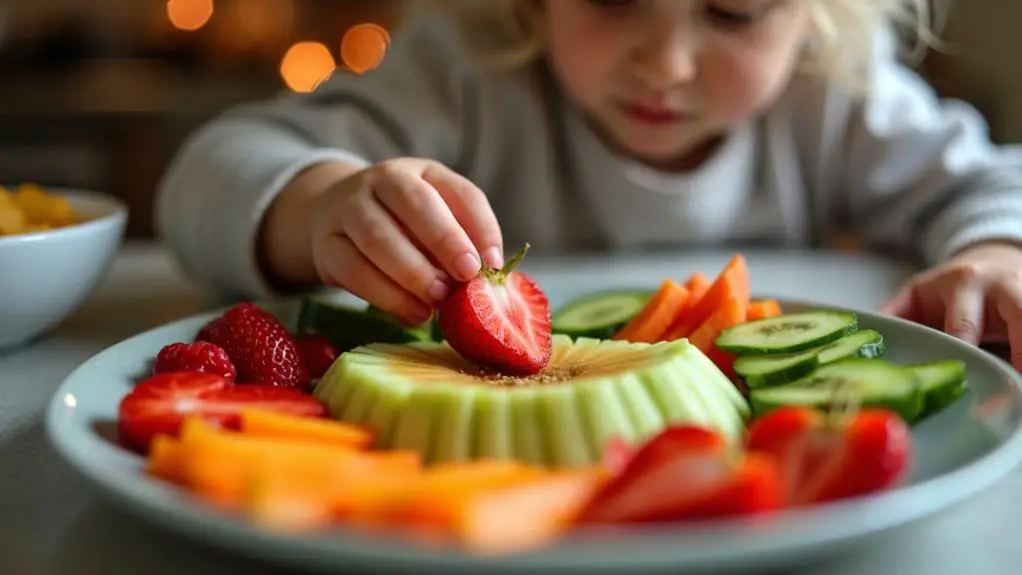Teaching Kids About Mindful Eating
Teaching kids mindful eating helps them develop a healthy relationship with food. You can start by engaging all five senses during meals, encouraging small, savored bites, and creating a distraction-free eating environment. Involve children in cooking activities to foster appreciation and teach them to recognize hunger and fullness cues. Establish consistent meal times, serve family-style, and encourage open conversations about food. Overcome challenges by creating a calm atmosphere, addressing emotional eating, and fostering food exploration. By implementing these strategies, you'll equip your children with lifelong skills for healthy eating habits. Discover more ways to nurture mindful eaters in your family.
Key Takeaways
- Engage children's senses during meals to heighten food awareness and appreciation.
- Teach kids to recognize natural hunger and fullness cues using a simple hunger scale.
- Create a distraction-free eating environment to promote focus on the meal experience.
- Involve children in cooking activities to foster a deeper connection with their food.
- Encourage open conversations about food to address anxieties and promote a positive relationship with eating.
Understanding Mindful Eating
Mindful eating is more than just a trendy buzzword; it's a powerful approach to developing a healthier relationship with food.
When you practice mindful eating, you engage all five senses during meals, enhancing your appreciation and awareness of what you're consuming.
This technique encourages you to recognize your body's natural hunger and fullness cues, helping you avoid overeating and emotional eating.
Benefits for Children
While mindful eating offers numerous advantages for adults, its benefits for children are equally impressive. By teaching your kids mindful eating practices, you'll help them develop a healthy relationship with food.
They'll learn to recognize their hunger and fullness cues, preventing overeating and promoting better eating habits. Mindful eating also encourages children to explore new foods and appreciate their sensory qualities, leading to a more varied and nutrient-rich diet.
You'll notice improved self-awareness and emotional regulation in your children as they engage in mindful eating activities. This enhanced focus can positively impact other areas of their lives.
Additionally, mindful eating reduces feelings of guilt associated with food, fostering enjoyment during meals. Research shows that these practices can lower the risk of childhood obesity by promoting healthier eating behaviors and mindful decision-making about food choices.
Practical Mindful Eating Techniques

How can you introduce mindful eating practices to your children in a fun and engaging way? Start by encouraging them to explore their food with all five senses. Let them touch, smell, look at, listen to, and taste their meals. Teach them to take small, mindful bites, savoring each flavor. This mindfulness practice helps kids recognize fullness cues more effectively.
Create a distraction-free eating environment by limiting screen time during meals. Involve children in cooking activities to enhance their appreciation for food.
Use the hunger scale to help them assess their hunger levels before eating, teaching them to differentiate between physical and emotional triggers. These techniques promote healthy eating habits and foster a deeper connection with food. By implementing these practical strategies, you'll help your children develop a more mindful approach to eating.
Creating a Positive Eating Environment
Building on these mindful eating techniques, it's important to contemplate the overall environment in which your children eat.
Creating a positive eating atmosphere can greatly impact your child's relationship with food and encourage mindful eating habits.
To foster this environment, consider the following:
- Establish consistent meal and snack times every 2-3 hours
- Serve meals family-style to empower children's food choices
- Minimize distractions during mealtimes
- Encourage open conversations about food
Overcoming Common Challenges

Implementing mindful eating practices with children can present unique challenges. To overcome distractions, create a calm, screen-free environment during mealtimes. This helps kids focus on their food and hunger cues.
Address emotional eating by teaching children to distinguish between physical hunger and emotional triggers, promoting healthier eating habits.
Engage kids in cooking to foster appreciation for food and willingness to try new things. Establish a routine with meals and snacks every 2-3 hours to prevent overeating due to hunger or lack of structure.
Encourage open discussions about food preferences and experiences to address anxieties and misconceptions, promoting a positive relationship with food.
Conclusion
You've got the tools to help your kids develop a healthy relationship with food. Remember, "Rome wasn't built in a day," and mindful eating habits take time to cultivate. Stay patient and lead by example. As you create a positive eating environment and overcome challenges together, you'll see your children grow more aware of their bodies and food choices. Keep nurturing these skills, and you'll set them up for a lifetime of balanced, joyful eating.







